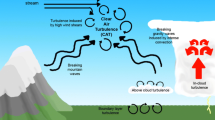Summary
In this paper, we describe the results of 44 case study analyses of synoptic scale data sets that define the atmospheric structure prior to the development of accident-producing turbulence. First, the 44 case studies are categorized as a function of the location, altitude, time of year, time of day, and turbulence environment, i.e., in clear air, cloudiness, convection, near mountains, or in the proximity of deep convection. It is noteworthy that this later category was much more ubiquitous than was anticipated. Second, NCEP Reanalysis data sets as well as both visible and infrared satellite imagery are employed to diagnose “predictor” fields associated with the synoptic-scale environment preceding severe turbulence. These predictor fields are calculated based on jet stream configuration, kinematic, dynamical, and thermodynamic analyses of the synoptic-scale atmosphere.
The results of these analyses indicate a prevalence of severe accident-producing turbulence within the entrance region of the polar or subtropical jet stream at the synoptic-scale. Typically, there is a region of flow curvature located just upstream within the jet entrance region, convection is present within 100 km of the accident, the vertical motion is upward typically within the curved entrance region, absolute vorticity is low, the vertical wind shear is increasing with time, and horizontal cold air advection is substantial. Not all of the 44-case studies conform to this entrance region paradigm. However, most do and the most consistent predictor of severe turbulence is upstream curvature in the synoptic-scale flow. Nearby convection is the second most ubiquitous predictor field. Upward vertical motion, low absolute vorticity, and horizontal cold air advection are all typical predictors in case studies occurring both within the entrance and exit regions of the polar or subtropical jet stream.
Similar content being viewed by others
References
E Chambers (1955) ArticleTitleClear air turbulence and civil jet operation. J Roy Aeronaut Soc 59 613–628
TL Clark WD Hall RM Kerr D Middleton L Radke FM Ralph PJ Nieman D Levinson (2000) ArticleTitleOrigins of aircraft-damaging clear air turbulence during the 9 December 1992 Colorado downslope windstorm: Numerical simulations and comparison to observations. J Atmos Sci 57 1105–1131
GP Ellrod DI Knapp (1992) ArticleTitleAn objective clear-air turbulence forecasting technique: Verification and operational use. Wea Forecast 7 150–165
RM Endlich (1964) ArticleTitleThe mesoscale structure of some regions of clear-air turbulence. J Appl Meteor 3 261–276
E Kalnay co-authors (1996) ArticleTitleThe NMC/NCAR 40-year Reanalysis project. Bull Amer Meteor Soc 77 IssueID3 437–471
ML Kaplan SE Koch Y-L Lin RP Weglarz RA Rozumalski (1997) ArticleTitleNumerical simulations of a gravity wave event over CCOPE. Part I: The role of geostrophic adjustment in mesoscale jetlet formation. Mon Wea Rev 125 1185–1211
Kaplan ML, Lin Y-L, Riordan AJ, Lux KM, Huffman AW (2000) Observational and numerical simulation-derived factors that characterize turbulence accident environments. Preprints, 9th AMS Conf. on Aerospace, Range, and Aeronautical Meteorology, 11–15 September 2000 Orlando, FL, pp 476–481
JL Keller (1990) ArticleTitleClear air turbulence as a response to meso- and synoptic-scale dynamical processes. Mon Wea Rev 118 2228–2242
JA Knox (1997) ArticleTitlePossible mechanisms of clear air turbulence in strongly anticyclonic flows. Mon Wea Rev 125 1251–1259
TP Lane RD Sharman TL Clark H-M Hsu (2003) ArticleTitleAn investigation of turbulence generation mechanisms above deep convection. J Atmos Sci 60 1297–1321
DK Lilly EJ Zipser (1972) ArticleTitleThe front range windstorm of 11 January 1972: A meteorological narrative. Weatherwise 25 56–63
RL Mancuso RM Endlich (1966) ArticleTitleClear air turbulence frequency as a function of wind shear and deformation. Mon Wea Rev 94 581–585
Marroquin A (1998) An advanced algorithm to diagnose atmospheric turbulence using numerical model output. Preprints, 16th AMS Conf. on Weather Analysis and Forecasting, 11–16 January 1998, Phoenix, AZ, pp 79–81
Marroquin A, Smirnova TG, Brown JM, Benjamin SG (1998) J4.7 Forecast performance of a prognostic turbulence formulation implemented in the MAPS/RUC model. Preprints, 16th AMS Conf. on Weather Analysis and Forecasting, 11–16, January 1998, Phoenix, AZ, J123–125
RJ Reed KR Hardy (1972) ArticleTitleA case study of persistent, intense clear air turbulence in an upper-level frontal zone. J Appl Meteor 12 541–549
ER Reiter A Nania (1964) ArticleTitleJet-stream structure and clear-air turbulence. J Appl Meteor 3 247–260
WT Roach (1970) ArticleTitleOn the influence of synoptic development on the influence of high-level turbulence. Quart J Roy Meteor Soc 96 413–429
Sharman R, Wiener G, Brown B (2000) Description and integration of the NCAR Integrated Turbulence Forecasting Algorithm (ITFA). AIAA 00-0493, AIAA 38th Aerospace Sciences Meeting and Exhibit, 10–13 January 2000, AIAA, Reno, NV
LW Uccellini KF Brill RA Petersen D Keyser R Aune PJ Kocin M des Jardins (1986) ArticleTitleA report on the upper-level wind conditions preceding and during the Shuttle Challenger (STS 51L) explosion. Bull Amer Meteor Soc 67 1248–1265
U.S. Department of Transportation (1998) Press release
Author information
Authors and Affiliations
Additional information
Current affiliation: USDA/Forest Service, North Central Research Station, East Lansing, MI 48823.
Rights and permissions
About this article
Cite this article
Kaplan, M., Huffman, A., Lux, K. et al. Characterizing the severe turbulence environments associated with commercial aviation accidents. Part 1: A 44-case study synoptic observational analyses. Meteorol. Atmos. Phys. 88, 129–152 (2005). https://doi.org/10.1007/s00703-004-0080-0
Received:
Accepted:
Published:
Issue Date:
DOI: https://doi.org/10.1007/s00703-004-0080-0



